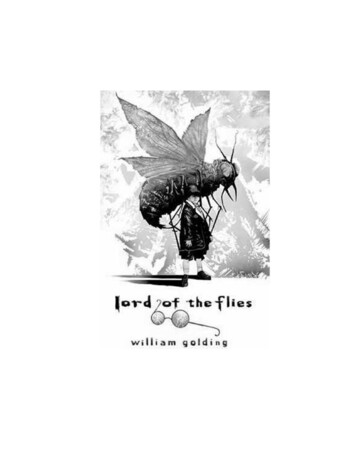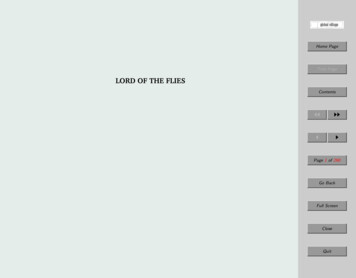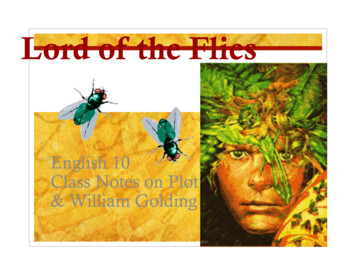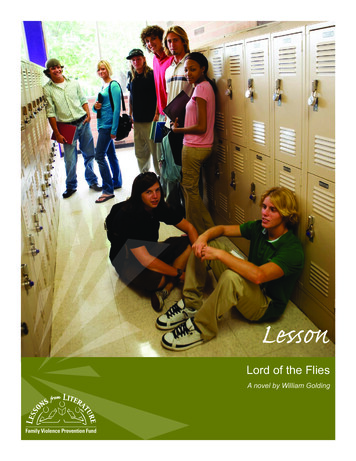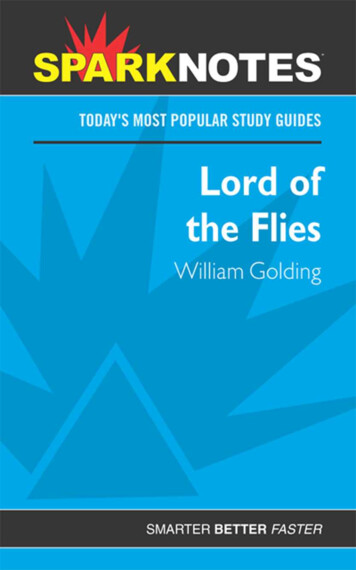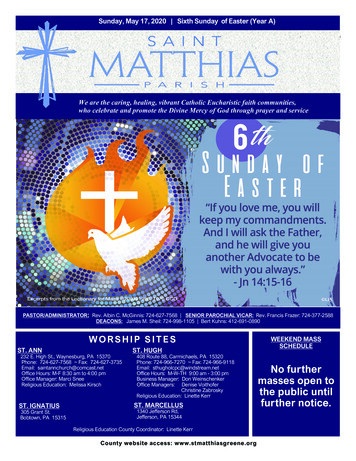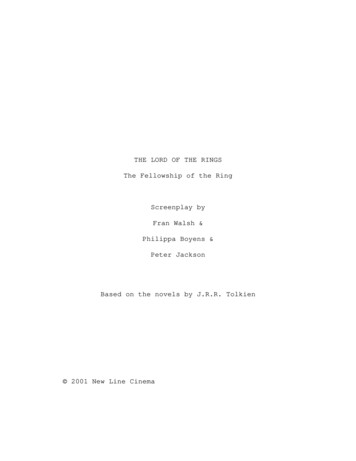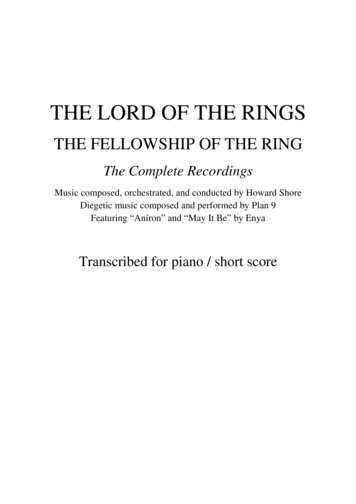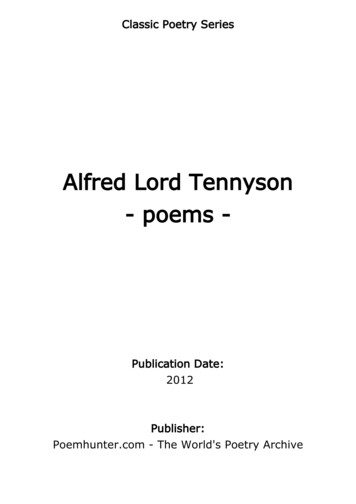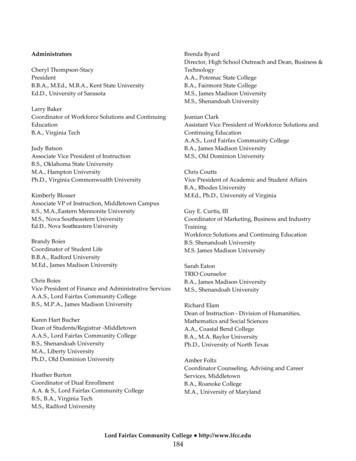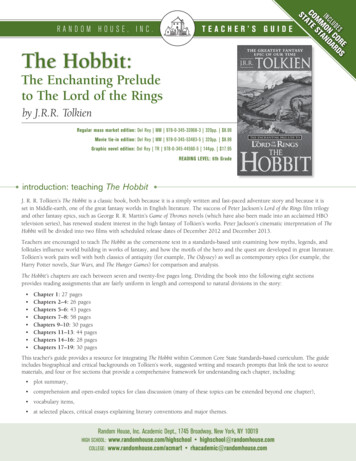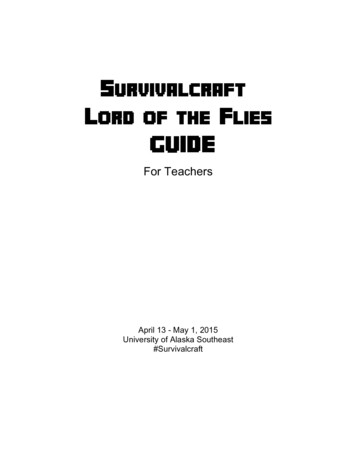
Transcription
sUrvivAlCrAftlOrd Of the fliesGUideFor TeachersApril 13 - May 1, 2015University of Alaska Southeast#Survivalcraft
Table of ContentsIntroduction .3Timetable .4WHY MINECRAFTEDU?.5TECHNOLOGY REQUIREMENTS 6TEACHER RESPONSIBILITIES .8UNIT PLAN .9I. Text:II. Standards:III. Transfer Goal:IV. Understandings:V. Essential Questions:Content: CCS and Alaska StandardsTechnology: ISTE NETSVI. Evaluation:Artifact to be gradedRubricsResources: .19Survivalcraft: Lord of the Flies: Scenario 1Survivalcraft: Lord of the Flies: Scenario 2Survivalcraft: Lord of the Flies: Scenario 3Survivalcraft: Lord of the Flies: Scenario 1 for studentsSurvivalcraft: Lord of the Flies: Scenario 2 for studentsSurvivalcraft: Lord of the Flies: Scenario 3 for studentsThe Survivalcraft: Lord of the Flies Community AgreementSample Parent LetterTeacher Menu GuideBehavior Management Tools & Examples2
IntroductionCongratulations! You and your students have joined the three-week Survivalcraft: Lordof the Flies experience in MinecraftEdu, which will take place from April 13 - May 1,2015!In this experience, students will build the setting for the story of “Lord of the Flies” byWilliam Golding, and then live within those settings as they experience elements of theplot and are invited to explore themes, make inferences and analyze characterdevelopment in an engaging and interactive MinecraftEdu environment.In this guide, you have been provided with a full lesson plan with resources andinformation about the MinecraftEdu client software with access to our secure server inwhich only participants in this project will be present. As part of your participation, youwill receive ongoing support from experienced teachers and professionals duringSurvivalcraft: Lord of the Flies.3
TimetableYou are encouraged to review and follow this timetable:Before Survivalcraft: Lord of the Flies Assign your students to read the book “Lord of the Flies” Join the Survivalcraft Google Community, an invite has been sent to your email. Review the Teacher Training course http://survivalcraft15.weebly.com designedto show you the MinecraftEdu Teacher Tools and to review the Unit Plan andadditional resources.Week OneIntroduce and guide students through Scenario 1. This should include at leastone (1) hour to walk students through their username and login process for theMinecraftEdu client and to setup their individual Wikispaces page. Discuss theCommunity Agreement with students (or adapt it to your classroom managementplan). You may choose to perform these tasks the week before to allow forenough time in the game during this week. For class time, plan for students tospend five (5) hours in MinecraftEdu which may include up to two (2) hours insupport activities, such as discussions, taking/saving/editing screenshots ofstudent work, and writing student reflections in individual Wiksipaces pages.Week TwoIntroduce and guide students through Scenario 2. Your prep time may includeup to two (2) hours for evaluating student work from Scenario 1 and preparingthe MinecraftEdu world for Scenario 2. For class time, plan for students to spendfive (5) hours in MinecraftEdu which may include up to two (2) hours in supportactivities, such as discussions, taking/saving/editing screenshots of student work,and writing student reflections in individual Wiksipaces pages.Week ThreeIntroduce and guide students through Scenario 3. Your prep time may includeup to two (2) hours for evaluating student work from Scenario 2 and preparingthe MinecraftEdu world for Scenario 3. For class time, plan for students to spendfive (5) hours in MinecraftEdu which may include up to two (2) hours in supportactivities, such as discussions, taking/saving/editing screenshots of student work,and writing student reflections in individual Wiksipaces pages.4
WHY MINECRAFTEDU?“One of the best ways to improve how students display their reading comprehensionis asking them to create a visualization”(Miller, 2014).MinecraftEdu brings elements of integration, technology and extreme engagement intothe classroom. Students will challenge themselves, take their projects further anddemonstrate their knowledge of learning through this project-based course. MinecraftEdu gives students the independence to createAs students are involved in problem-solving, the game can motivate students’higher-level and critical thinkingMinecraftEdu is a social game, encouraging collaboration and teamworkBuilt-in methods of differentiation insure that teachers and students can adapt thecourse to fit their individual or class needs. This three-week unit will:1. Meet new Alaska Literacy Standards or the Common Core Literacy Standards grades 6th-12th2. Let students expand on the book with their own thoughts and ideas3. Encourage students to collaborate and explore4. Provide teachers with a planned guide for integrating technology5. Let teachers explore gamification in a safe, guided environment on a privateMinecraftEDU server provided through UASFor further information on how MinecraftEdu is different from the original Minecraftgame, please visit: http://services.minecraftedu.com/wiki/What is MinecraftEdu5
TECHNOLOGY REQUREMENTSMinecraftEdu will not run on mobile devices, tablets such as iPads, or netbooks such asChromebook.UAS has graciously supported this endeavor by providing a minecraftEDU server andall associated fees so all Survivalcraft: Lord of the Flies participants need to do isdownload the client, not the whole program.For specific technical requirements, please see Appendix Minecraft SystemRequirements – Mojang or cles/325948-minecraft-system-requirementsMinecraft system t Updated: Jul 22, 2014 09:09PM CESTThis information has been compiled by the Minecraft community on the Minecraft wiki. Pleasevisit the Hardware Performance wiki page for the most up to date information, or to compareyour computer's hardware and softwar with other users' computers listed as being able to playthe game.A computer with the minimum requirements should be able to play Minecraft. However, for thebest experience, please consider the recommended requirements.Minimum Requirements: CPU: Intel Pentium D or AMD Athlon 64 (K8) 2.6 GHz RAM: 2GB GPU(Integrated): Intel HD Graphics or AMD (formerly ATI) Radeon HD Graphics with OpenGL 2.1GPU (Discrete): Nvidia GeForce 9600 GT or AMD Radeon HD 2400 with OpenGL 3.1 HDD: Atleast 200MB for Game Core and Other Files Java 6 Release 45Recommended Requirements: CPU: Intel Core i3 or AMD Athlon II (K10) 2.8 GHz RAM:4GB GPU: GeForce 2xx Series or AMD Radeon HD 5xxx Series (Excluding IntegratedChipsets) with OpenGL 3. HDD: 1GB Latest release of Java 7 from java.comSoftware Requirements: Minecraft Release 1.6 or newer. Older versions will need to be updatedto current versions Please note that some users experience issues playing Minecraft while usinga mismatched version of Javafor their operating system (32 or 64 bit), while using certain versions of Java 7, or while multipleversions of Java are installedIf you have a laptop with an a built-in (integrated) graphics card, rather than a dedicated card, itis highly suggested that you try the les/425381-minecraft-demo-mode) beforepurchase.6
A stable internet connection is required for Minecraft to download game files, authenticateusernames, and connect to multiplayer servers. You'll need to download and run Minecraft whileconnected to the internet at least once; afterwards, you can play without an internet connection,but will need to connect if you'd like to receive updates or play onlineMinecraft will not run on a toaster (despite some actually using Java), your car (feel free toprove us wrong, though), or a Chromebook.7
TEACHER RESPONSIBILITIESUse this checklist to keep track of your tasks during the Survivalcraft: Lord of theFlies experience.By registering for the Survivalcraft: Lord of the Flies experience, teachers areexpected to: Assign students to read “Lord of the Flies,” by William Golding. Download, install and test MinecraftEdu client software on student computers inadvance, to ensure that students are able to begin the Survivalcraft: Lord of theFlies experience on time. Make time to discuss technical issues with school ITstaff to ensure that the client is working properly. Send a class roster to Dr. Lee Graham to be used for creating studentusernames and passwords; students will also use these usernames to log intothe MinecraftEdu client. Join the Google Group for Survivalcraft: Lord of the Flies Teachers named “TheSurvivalcraft: Lord of the Flies Community”; an invitation will be sent to the emailaddress indicated on the registration form. Review Survivalcraft: Lord of the Flies Unit Plan and discuss implementationquestions and concerns with Dr. Lee Graham, the Survivalcraft: Lord of the FliesTeam, or other teachers as needed through the Google Groups forum. Review the Community Agreement with students and have them each sign acopy. Create a Wikispaces home page for each participating class and regularly updatethe page with instructions for students and to share highlights and progress fromeach class. Teachers should model and encourage collaboration from studentsin the wiki. Attend the required teacher training sessions on using MinecraftEdu teachertools and to discuss the unit plan and timeline for the Survivalcraft: Lord of theFlies experience. Finalize the schedule of when your students will be in the game over the threeweek period; send this schedule to the Dr. Lee Graham. This includes ensuringthat students have enough time to complete each scenario and the tasksrequired. Create a zone in the MinecraftEdu world for each participating class; place aborder, teleport blocks, and other special blocks as needed. Monitor and manage students when they are logged into the MinecraftEdu worldand enforce the Community Agreement as needed. Assess student work according to chosen standards, the relevant rubrics, andreport data to Dr. Lee Graham and the Survivalcraft: Lord of the Flies Team. Communicate issues, concerns, or questions to Dr. Lee Graham and theSurvivalcraft: Lord of the Flies Team through the Google Groups forum.8
UNIT PLANI. Texts:.Lord of the Flies by William GoldingII. Standards:Teachers may choose to use as many or as few of these standards as they like. In order to be apart of the #survivalcraft experience, teachers must choose to use at least three standards andchoose to share student achievement concerning these standards with others in the experience.Only aggregate data is shared – student identities are not revealed in any way during thisexperience.Common Core/Alaska Standards (Grades 6-12):Key Ideas and Details1. Read closely to determine what the text says explicitly and to make logical inferences from it;cite specific textual evidence when writing or speaking to support conclusions drawn from thetext.2. Determine central ideas or themes of a text and analyze their development; summarize thekey supporting details and ideas.3. Analyze how and why individuals, events, and ideas develop and interact over the course of atext.Research to Build and Present Knowledge9. Draw evidence from literary or informational texts to support analysis, reflection, andresearch.Integration of knowledge and ideas9
7. Integrate and evaluate content presented in diverse media and formats, including visually andquantitatively, as well as in words.9. Analyze how two or more texts address similar themes or topics in order to build knowledgeor to compare the approaches the authors take. **Only for classes using both The Maze Runner and Lord of the FliesISTE NETS Standards1. Creativity and innovation: Students demonstrate creative thinking, construct knowledge, anddevelop innovative products and processes using technology.a. Apply existing knowledge to generate new ideas, products, or processesb. Create original works as a means of personal or group expressionc. Use models and simulations to explore complex systems and issues2. Communication and collaboration: Students use digital media and environments tocommunicate and work collaboratively, including at a distance, to support individual learningandc ontribute to the learning of others.a. Interact, collaborate, and publish with peers, experts, or others employing a variety ofdigital environments and mediab. Communicate information and ideas effectively to multiple audiences using a varietyof media and formatsc. Develop cultural understanding and global awareness by engaging with learners ofother culturesd. Contribute to project teams to produce original works or solve problems5. Digital citizenship: Students understand human, cultural, and societal issues related totechnology and practice legal and ethical behavior.a. Advocate and practice safe, legal, and responsible use of information andtechnology10
b. Exhibit a positive attitude toward using technology that supports collaboration,learning, and productivityc. Demonstrate personal responsibility for lifelong learningd. Exhibit leadership for digital citizenshipIII. Transfer GoalStudents will be able to independently use their learning to create, and engage in simulations inorder to enhance and make concrete knowledge gained from interaction with quality young adultliterature.IV. UnderstandingsContent: (CCS and Alaska Standards)Students will understand that:1. When writers choose words, they are creating specific pictures that contribute to thestory development. (CCS/Alaska Key 1)2. The specific words the writers choose matter and can influence the progress of a storyor the development of a character. (CCS/Alaska Key 1)3. Ultimately, a story could develop in any number of ways, and exploring alternative storydevelopment is fully open to the reader. (CCS/Alaska Key 1)4. The themes of stories create frameworks for understanding; there’s a great deal offreedom within themes – and the reader has control over extended theme development.(CCS/Alaska Key 2)5. Interaction of themes, characters, and ideas in quality literature create an ultimateexperience in which engagement is natural and seamless. (CCS/Alaska Key 3)6. Many skills can be enhanced through online resources (written, video, and interactive).(CCS/Alaska Research 9)7. Use of simulation and gaming as well as wiki writing assists the reader in deconstructing, “living”, and understanding quality literature. (CCS/Alaska Integration 7)8. While The Lord of the Flies and MazeRunner use sometimes identical themes, theauthors of each book created specific experiences within those themes to make theexperience unique to their purpose and story. (CCS/Alaska Integration 9)11
Technology: ISTE NETSStudents will understand that:1. They can create systems of behavior and performance in virtual environments in order tocreate original works based on literature. (NETS 1.a.)2. They can build worlds and participate in role play to assist in understanding literarycontent. (NETS 1.b)3. They can deepen and extend their understanding of literary works through living in theworlds they have created (NETS 2.c.)4. Certain rules and norms are necessary to “live” and solve problems effectively in avirtual environment with others. (NETS 2.a. & NETS 5.a, 5.b. & 5.d.)5. Different ways of communication are important as we talk or work together in a virtualsimulation vs. individual work on the Wiki, vs. individual pencil and paper work. (NETS2.b.)6. Not all people believe or operate in the same way that we do within our culture. (NETS2.c.)7. Team planning contributes to the impact and effectiveness of construction within thevirtual world. (NETS 2.d.)8. Many resources are available in a variety of formats to assist us in maintaining currencywith technology. (NETS 5.c.)V. Essential Questions:Content: (CCS and Alaska Standards)1. What quotes or words are descriptive enough to help me to recreate the world from thebook I am reading? (CCS Key 1)2. How would my building be different if similar words – but not exactly the same words –were used as the story progressed or as the character developed? (CCS Key 1)3. How do I believe the actual storyline ends, beyond the final sentence of the novel?(CCS Key 1)4. What happened to characters during the times they actually are not appearing in thestories? How do I know? (CCS Key 1)5. Would the area I built have been as good if one primary theme had been changed? Whyor why not? (CCS Key 2)6. How my building benefit from the themes developing in the way they did? (CCS Key 3)7. Had the themes in the story not developed like they did, how could the building you didhave changed? (CCS Key 3)8. How can I find out how to do something you don’t know how to do in Minecraft? (CCSResearch 9)9. What are my favorite Minecraft resources online? (CCS Research 9)10. Do I think the similarities in themes between The Maze Runner and Lord of the Flies aregreater than the differences? Why or why not? (CCS Integration 9)12
Technology: ISTE NETS1. How do I have to change or adapt information from the book so that my character canlive in the society my group created?(NETS 1.a.)2. How does living in the simulation change or inform my understanding of the book I read?(NETS 2.c.)3. How do rules, expectations, or consequences for behaviors happen within in the worldthat we created? (NETS 2.a., NETS 5.a., NETS 5.b. & NETS 5.d.)4. How do I communicate with others differently if I am in the Wiki, or if I am in the virtualworld, or if I am just writing a paper? (NETS 2.b.)5. Do the people in my virtual world believe the same things, and have the same values aspeople in my physical world have? (NETS 2.c.)6. How did the team’s approach to building help or hinder the creation of our virtual world?(NETS 2.d.)7. How did I find out how to build things or do things I didn’t know how to do in the virtualworld?13
VI. EvaluationArtifact to be graded:As students play the game, they should take screenshots and create signs and books toindicate how they have demonstrated an understanding of the themes of the game. It isrecommended that students are allowed to take 2 hours each week to write in theirwikis, and to post their screenshots. A teacher/student help pages will be provided onthe wiki.Wiki address is: http://survivalcraft15.wikispaces.com/And the join code is: HCM4MN914
RubricsEach criterion of the rubric (represented by a row) represents a standard within the experience.Each criterion may be used independently of the other. You will score only the criterion for theCC/Alaska or NETS standards you have chosen for your students’ three-week experience.In order to provide evidence that each criterion is met, students should take screenshots, anduse Wikispaces to document their work, and to share this evidence with the teacher.15
CriterionCCS KeyIdeas andDetails 1.CCS KeyIdeas andDetails 2.CCS KeyIdeas andDetails 2.Not MetStudentconstruction (asrecorded throughscreenshots in theWiki) mayresembleinformationrepresented in thetext – but specificsare not cited, andthere is notevidence thatstudents haveconsidered theimpact of thedetailed choicesmade by theauthor on thestoryline.While the studentmay understandthere are themesin the text, they donot identify thesethemes in the wiki,or studentdocuments themeswhich do not existin the book(s).Very little analysisof charactermotives and theimpact of thesemotives on thestoryline aredemonstrated, orstudent incorrectlyattributes motivesMetIn the wiki, studentuses references:words, passages,and/or phrases, toindicate that theconstructioncreated or actiontaken derives fromand follows thetext.ExceedsIn the wiki, studentuses detailedreferences includingwords, passages, andphrases, to indicatethat the constructioncreated or actiontaken in thesimulation derivesfrom and follows thetext in a precise way.Student correctlyidentifies themes inthe text,documenting thesethemes within theworld anddemonstrating anunderstanding ofhow these themesare developedthrough usingscreenshots todocument thethemes within theirwiki.Student correctlyidentifies severalthemes in the text,using signs,buildings, and othercreative constructionsto identify thesethemes within theworld. A deep andspecificunderstanding of theway that thesethemes aredeveloped isdemonstrated in theWiki through use ofscreenshots andtextual explanation.Through the Wiki,Through the Wiki, thethe studentstudent uses roleanalyses of theplay and simulation tomotives of theconduct an analysischaracters and the of the motives of theprogression of thecharacters and thestoryline. Students progression of thecreate a convincing storyline. Studentscase throughcreate a convincing16
to characters, orstudentdemonstrates verylittle understandingof the reason thestorylinedeveloped as itdid.narrative,screenshots,and/or screencaststhat theyunderstand whythe charactersbehaved as theydid, and howcharacter behaviorcontributed to thestoryline.Student buildsskills in Minecraftthrough onlineresearch, andshares andsummarizesresources found ontheir Wiki, using acuration tool suchas PearlTrees orDiigo.CCS 9.Research toBuild andPresentKnowledgeLittle or noevidence thatstudents buildsskills in Minecraftthrough onlineresearch.CCS 7.Integrationofknowledgeand ideas.Studentsdemonstrate theirunderstandingprimarily throughuse of Minecraftblocks andscreenshots, orthrough text on thewiki.Student use somevariety of mediaincluding Minecraftblocks,screenshots andtext, to assist indemonstrating theirunderstanding onthe Wiki.CCS 9.Integrationofknowledgeand ideas.Student mayidentify similarthemes withinMazeRunner andLord of the Flies,but no analysis ispresent ORStudentdemonstrates verylittle or nounderstanding ofsimilar themeswithinStudentsdemonstrate,through their Wiki,a well-formedanalysis of thedivergent approachto a similar themewithin MazeRunnerand Lord of theFlies.case through sharingnarrative,screenshots, and/orscreencasts thatdemonstrate theyunderstand why thecharacters behavedas they did, and howcharacter behaviorcontributed to thestoryline.Student builds skillsin Minecraft throughonline research, andshares using acuration tool such asPearlTrees or Diigo.In addition studentdocuments anddemonstrates theseskills by sharing howtos and strategies forresearch on theirWiki.Students use a richvariety of mediaincluding Minecraftblocks, Minecraftavatars, screenshots,curation tools, audioand/or webcasts toassist indemonstrating theirunderstanding on theWiki.Using MinecraftBlocks, Avatars,Screencasts orWebcasts, and theirWiki, studentsdemonstrate a richanalysis of thedivergent approach toa similar theme withinMazeRunner andLord of the Flies.17
NETS -1 a.& b.NETS 1. c.NETS 2. a.& 2.b.NETS 2.b.MazeRunner andLord of the Flies.Student isconfined toaccuracy as theycreate the world,building exactly asthings exist withinthe text, andbehaving exactlyas charactersbehave within thetext. There is littleor no evidence ofcontributions thatare individualexpressions of thestudent.Student mayengage inMinecraft;however, thisengagement isfocused onsomething otherthan the simulationof the world in thetext.Uses verbalcommunication inphysicalenvironment towork throughcollaboration withother students andwith teachersduring the project.Demonstrates anunwillingness tocommunicate orcollaborate withothers at adistance – orStudent creates anaccurate portrayalof the world withinthe book; however,the student addshis or her ownpersonalcontribution to theirportrayal in order tocreate somethingnew.Student movesbeyond the text tocreate a system ofbehavior, a way ofworking, a way ofbuilding and/orconstructions whichenhance (withoutstrictly replicating) theworld within the book.Student somewhatengages within theMinecraftenvironment toexplore thesimulation of theworld in the text.Student fully engageswithin the Minecraftenvironment in orderto explore thesimulation of theworld of the text.Use wiki andMinecraft tocommunicate withand work throughcollaboration withother students andwith teachersduring the project.Use wiki & Minecraftalong with withscreenshots,screencasts and/orother media orpublishing venues(such as Tumblr orYouTube) asavailable tocommunicate withand work throughcollaboration withother students andwith teachers duringthe project.Demonstratesproficiency incommunicating andcollaborating withother participantswho are at aDemonstrates awillingness andability tocommunicate andcollaborate withother participants18
demonstratesongoing reluctanceto engage incommunicationand collaborationwith otherparticipants at adistance.NETS 2.c.No evidence thatthe studentcontributed to thegroup OR studentcontribution isdisruptive anddistracts from theoverall experience.Nets 5. a, b, Student& d.demonstrates alack of awarenessor a lack of regardfor the norms andrules of the digitalcommunity.Student maydistract othersfrom their tasks,and/or may serveas a disruptivepresence in thecommunity.NETS 5.c.Studentsdemonstrate adependence onothers for findingresources forcreating andplaying inMinecraft. Theyconstantly turn tothe teacher forassistance.who are at adistance.distance.Student contributeswithin a group toenhance building,interactions, andthe overallexperience.Student leads andcontributes within agroup to enhancebuilding, interactions,and the overallexperience.Studentdemonstrates gooddigital citizenshipthrough mindingthe norms andrules set in thevirtual community.Studentdemonstratesexcellent digitalcitizenship throughassisting others,minding the normsand rules set in thevirtual community,and creating apositive and stablepresence within theexperience.Students seek outor are willing to findresources forcreating andplaying inMinecraft. Studentsdon’t mind sharingwith others.Students proactivelyseek out resourcesfor creating andplaying in Minecraft,and share theseresources generouslywith others.19
ResourcesThemes:Lord of the FliesSparknotesSchmoopGrade SaverVideo SparkNotes: William Golding's Lord of the Flies summaryhttps://www.youtube.com/watch?v -tXpA3dIEtILord of the Flies Trailer (Loft Cinema):https://www.youtube.com/watch?v c1x2wP5vP34Wiki site to be used for the experienceWiki address is: http://survivalcraft15.wikispaces.com/And the join code is: HCM4MN9ReferencesMiller, Andrew. (2014). Ideas for using minecraft in the classroom. Retrieved ssroom-andrew-millerAppendix pages follow.20
Survivalcraft: Lord of the FliesScenario One: Before the CrashNote: Players are in Creative Mode, and have plenty. After this world is created and built,students will be in a different location for Scenario Two – it is important that students understandthat nothing built in this world will be available to them when Scenario Two begins.You are one of the boys who will ultimately be stranded on an island, but the plane hasn’t yetcrashed. You haven’t even gotten on the plane yet!You are living in the world that exists prior to the story’s beginning. Use clues from the text tobuild this world. You may create a town, a school campus or any other structure(s) that the textsupports could have been the setting for boys prior to getting on the plane. Why did the boyseven get on the plane? What might their lives have been like? What were the structures thatsheltered them and made up their everyday existence? Be sure that your building is supported(or at the very least not refuted) by the text.Entire classes might plan these structures together OR groups or individual students may buildthese for themselves.Remember to put signs in front of your buildings to support, to the extent that you can, why youbelieve this community represents life before the crash, based on information in the text.21
Survivalcraft: Lord of the FliesScenario Two: On the IslandNote: Players must build, survive and live within the Jungle biome. Players must determine theirown laws for the world, and must create their own system of punishment. Players are inSurvival Mode. Survival and creation of a sustaining community are the goals in this scenario.You are stranded. Your plane has crashed with the other members of your class aboard! Youare left to your own devices, with no adults to tell you what to do. The first order of business is totry to survive and to try to help others survive. Your group might choose to elect a leader, tocreate your own laws, and to band together to build structures and stores so that you can allsurvive. Or you decide that you’d rather split into smaller groups with similar goals. However youdecide you will organize, remember that you can’t take survival for granted. Mining, farming,hunting and living will be of the utmost importance. Fortunately, the monsters which may existon the island don’t know you are here.Survival Mode is on.Weather is on.22
Survivalcraft: Lord of the FliesScenario Three: The symbols that make up our worldNote: Players are in Creative Mode.There is a great deal of symbolism in The Lord of the Flies. Have a discussion within your classabout these symbols. Some examples of these symbols include:The ConchThe Signal FirePiggy’s GlassesThe ScarTalk with your classmates about what these items symbolize and why they are important in thestory.With a group of your colleagues, come up with a symbol (or more than one) that represents thegroup. Build a community or add to your community from scenario 2 based on that symbol inMinecraft. When you have finished building, invite your colleagues into your community and askthem to write a book sharing what they believe your com
Assign your students to read the book “Lord of the Flies” Join the Survivalcraft Google Community, an invite has been sent to your email. . Lord of the Flies participants need to do is download the client, not the whole program. For specific tec
